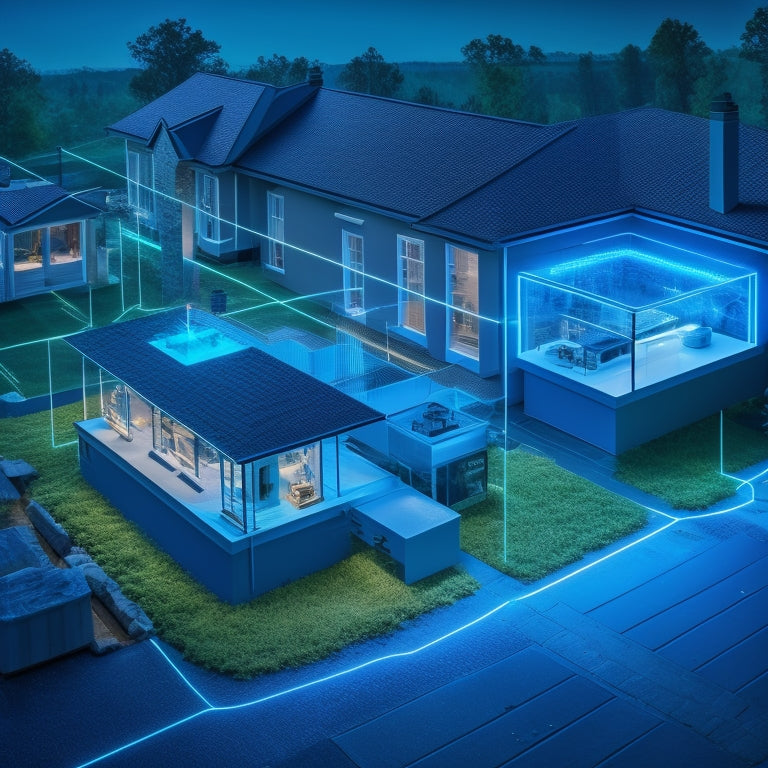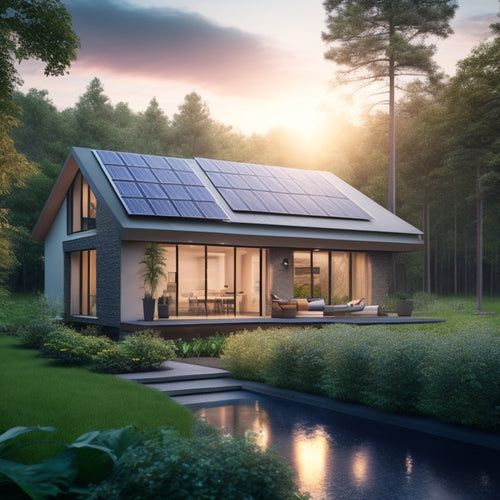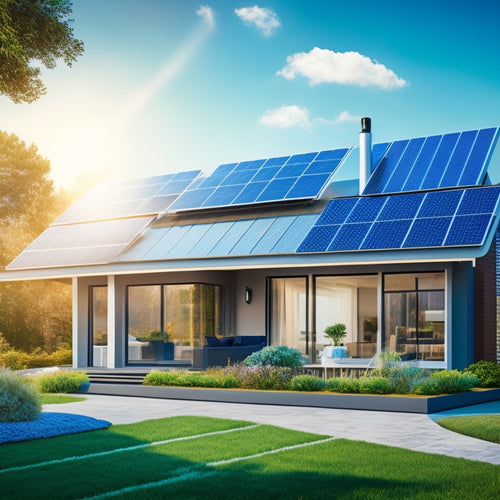
Integrate Energy-Saving Outlets Into Your Home Grid
Share
By integrating energy-saving outlets into your home grid, you can curb standby power consumption, which can account for up to 10% of your total energy usage, and start reducing your energy waste and ecological footprint today. These outlets employ smart plug technology to detect power profiles of devices, track real-time consumption, and identify optimization opportunities. Automatic shut-off features detect standby mode and cut power to prevent energy waste, enhancing energy efficiency and outlet safety. As you investigate the world of energy-saving outlets, you'll uncover more ways to optimize your home's energy consumption, leading you toward a more sustainable and cost-effective future.
Key Takeaways
- Choose the right energy-saving outlet type based on your energy-saving goals and device types for optimal integration.
- Ensure seamless integration with your existing smart home system or energy management platform for enhanced functionality.
- Verify compatibility with popular smart home devices and assess network connectivity via Wi-Fi, Zigbee, or Z-Wave for smooth communication.
- Follow the manufacturer's instructions for safe and proper installation, considering wiring specifications and power shutdown at the circuit breaker.
- Utilize energy monitoring systems and real-time tracking to identify optimization opportunities and reduce energy waste in your home grid.
Understanding Energy-Saving Outlets
Among the plethora of innovative solutions designed to reduce our ecological footprint, energy-saving outlets have emerged as a simple yet effective way to curb standby power consumption.
You're probably aware that many devices continue to draw power even when turned off but still plugged in. This standby power consumption can account for up to 10% of your total energy usage.
By implementing time-of-use rate strategies like those used in EV charging stations, we can optimize energy consumption during off-peak hours, further reducing our energy waste.
Energy-saving outlets address this issue by automatically cutting power to devices when they're not in use.
Benefits of Smart Grid Integration
Integrating energy-saving outlets with smart grid technology revolutionizes the way you manage your energy consumption, allowing you to optimize your power usage in real-time.
You'll gain unparalleled control over your energy usage, making it easier to reduce your carbon footprint and save on energy bills. By adopting a hybrid approach controlling consumption, you can maximize energy usage and minimize costs and environmental impact.
Smart grid integration also enables seamless renewable integration, allowing you to utilize the power of solar, wind, or other renewable sources. This results in a significant enhancement to grid efficiency, as your energy-saving outlets can adjust power output based on real-time energy availability.
How Energy-Saving Outlets Work
You'll find that energy-saving outlets rely on smart plug technology to detect and respond to the unique power profiles of individual devices. This is made possible by energy monitoring systems that track real-time power consumption and identify opportunities for optimization.
For instance, solar-powered stations can lead to potential annual savings of $500 to $2,000+, which is a significant incentive for businesses to integrate energy-saving outlets into their grid.
With an automatic shut-off feature, you can guarantee that standby power consumption is eliminated, reducing your overall energy waste.
Smart Plug Technology
What makes energy-saving outlets so intelligent? It's the smart plug technology that enables them. This advanced feature allows you to control and monitor your appliances remotely using your smartphone or voice assistant.
You'll enjoy smart plug features like scheduling, timer, and automation, giving you the freedom to manage your energy usage as you see fit. With the rise of fast charging infrastructure, smart plug technology is becoming increasingly important for optimizing energy efficiency.
By integrating energy-saving outlets into your home grid, you can greatly reduce your carbon footprint, contributing to a more sustainable future. Plus, smart plug compatibility with popular platforms like Amazon Alexa and Google Assistant guarantees seamless integration into your existing smart home ecosystem.
With smart plug technology, you can turn any device into a smart device, granting you unparalleled control over your energy consumption. By utilizing this innovative tech, you'll unfasten a new level of energy efficiency and flexibility in your home.
Energy Monitoring Systems
One essential aspect of energy-saving outlets lies in their energy monitoring systems, which enable users to track and regulate their energy consumption in real-time. This allows you to identify areas of inefficiency and make adjustments to optimize your power usage.
With a user-friendly interface, you can monitor energy consumption, analyze usage patterns, and adjust your habits to reduce your environmental impact. Renewable energy integration, such as solar power integration, can further enhance energy efficiency and reduce reliance on the grid.
By leveraging energy storage systems, you can optimize energy usage during off-peak hours and reduce peak demand on the grid.
-
Energy monitoring systems provide real-time data analytics on your energy consumption, helping you understand how to maximize power efficiency.
-
They offer device compatibility, allowing you to monitor multiple appliances and devices from a single interface.
-
By integrating with energy tariffs and demand response systems, energy monitoring systems can help you optimize your energy usage and reduce your energy bills.
Automatic Shut-Off Feature
As you go about your daily routine, it's easy to overlook the energy drain from appliances and devices on standby. However, energy-saving outlets with automatic shut-off features can help eliminate this unnecessary waste.
These outlets detect when a device is in standby mode and automatically cut power to it, preventing energy from being wasted. This feature not only enhances energy efficiency but also improves outlet safety by reducing the risk of overheating and electrical fires.
With an automatic shut-off feature, you can enjoy greater control over your energy consumption and reduce your environmental footprint. By integrating these outlets into your home grid, you'll be taking a significant step towards a more sustainable and energy-efficient living space.
Choosing the Right Outlet Type
Your outlet upgrade starts with selecting the right type, which depends on your specific energy-saving goals and the devices you plan to plug in.
You'll want to evaluate outlet compatibility and energy efficiency when making your choice.
-
Smart outlets: These advanced outlets can be controlled remotely, scheduled, and monitored for energy usage. They're ideal for devices that consume standby power, like TVs and computers.
-
Timed outlets: These outlets have built-in timers that allow you to set specific on/off schedules for your devices, helping you reduce energy waste when they're not in use.
-
Sensing outlets: These outlets can detect when a device is in standby mode and automatically cut power to it, eliminating standby power consumption and promoting energy efficiency.
Installation and Setup Process
With your outlet type selected, you're now ready to focus on the installation and setup process. Start by identifying the wiring considerations for your specific outlet type.
Verify you have the necessary installation tools, such as a voltage tester, wire strippers, and a screwdriver. Next, turn off the power to the outlet at the circuit breaker or fuse box.
Remove the faceplate and gently pull the old outlet out of the wall. Disconnect the wires from the old outlet, taking note of their colors and connections.
Connect the wires to the new energy-saving outlet, following the manufacturer's instructions. Finally, replace the faceplate and turn the power back on to test the outlet.
Integrating With Existing Systems
Smart home systems and energy management platforms can seamlessly integrate with energy-saving outlets to optimize energy efficiency and provide real-time monitoring.
This integration enables you to control and monitor your outlets remotely, receiving notifications and alerts when unusual energy usage patterns are detected.
To guarantee a smooth integration, consider the following:
-
Outlet compatibility: Verify the energy-saving outlets are compatible with your existing smart home system or energy management platform.
-
System requirements: Confirm that your system meets the minimum requirements for integration, including software updates and hardware compatibility.
-
Network connectivity: Ensure that your outlets can connect to your network, either through Wi-Fi, Zigbee, or Z-Wave, to enable seamless communication with your smart home system.
Monitoring and Controlling Energy
You'll need to track your energy usage to optimize your energy-saving outlets' performance.
With real-time monitoring, you'll be able to identify areas of inefficiency and make data-driven decisions to reduce your energy consumption.
Energy Usage Tracking
Your home's energy usage is a complex phenomenon, influenced by various factors like appliance efficiency, usage patterns, and even the time of day.
To optimize energy consumption, you need to understand these factors and identify areas for improvement. Conducting household energy audits helps you pinpoint energy-hungry devices and identify opportunities to reduce energy waste.
-
Identify energy consumption patterns: Analyze your energy usage data to determine when and how you use energy the most.
-
Pinpoint energy-hungry devices: Use energy monitoring tools to identify appliances and devices that consume the most energy.
-
Develop a plan to reduce energy waste: Based on your findings, create a plan to optimize energy usage and reduce energy consumption.
Real-Time Monitoring
Immerse yourself in the world of real-time monitoring, where instant feedback enables you to take control of your energy consumption.
With advanced energy-saving outlets, you'll gain access to real-time data, providing a clear representation of your energy usage. This instant feedback allows you to identify areas of inefficiency and make adjustments on the fly.
Energy analytics will help you pinpoint which devices are consuming the most power, enabling you to optimize your usage and reduce waste.
By staying informed, you'll be equipped to make conscious decisions about your energy consumption, giving you the freedom to live more sustainably and save on your energy bills.
Take the reins and start monitoring your energy usage in real-time – the power is in your hands.
Smart Home Automation
Step into the domain of smart home automation, where advanced energy-saving outlets seamlessly integrate with your existing setup, enabling you to monitor and control your energy consumption with precision.
With smart device compatibility, you can effortlessly connect your outlets to popular smart home systems, ensuring a unified and streamlined experience. Through an intuitive user interface design, you'll have complete control over your energy usage, receiving real-time updates and notifications to optimize your consumption.
- Remotely turn devices on/off and adjust their energy consumption
- Set schedules and routines to automate your energy usage
- Receive personalized energy usage reports and recommendations for improvement
Cost Savings and ROI Analysis
By installing energy-saving outlets, you can considerably reduce your energy consumption, leading to substantial cost savings over time.
The initial investment in these outlets may seem intimidating, but it's crucial to reflect on the long-term savings. On average, energy-saving outlets can save you around $100 per year on your electricity bill. Over a decade, this translates to $1,000 in savings, making the initial investment a worthwhile expenditure.
Additionally, many energy-saving outlets come with features like automated shut-off and scheduling, which can further optimize your energy usage.
Future of Smart Power Outlets
The proliferation of smart home devices has led to an increased demand for advanced power outlets that can efficiently manage and optimize energy distribution. As you look to integrate energy-saving outlets into your home grid, you're likely wondering what the future holds for these innovative devices.
Future innovations in smart power outlets will focus on enhancing their ability to detect and respond to your energy needs in real-time. This will lead to even greater energy efficiency and cost savings.
-
Increased automation: Expect smart outlets to integrate with other smart home devices, allowing for seamless energy management and optimization.
-
Advanced energy monitoring: Future outlets will provide real-time energy usage data, enabling you to make informed decisions about your energy consumption and reduce your carbon footprint.
-
Integration with sustainable energy sources: Smart outlets will be designed to work in tandem with renewable energy sources, such as solar and wind power, to create a more sustainable energy ecosystem.
Frequently Asked Questions
Can I Install Energy-Saving Outlets in an Existing Home?
You can install energy-saving outlets in your existing home, but it's essential to understand the installation process and choose the right outlet types, like smart or timer-based outlets, to guarantee a seamless and efficient integration with your current electrical system.
Will Smart Outlets Slow Down My Internet Speed?
As you weave a web of smart devices, don't let internet connectivity concerns ensnare you - rest assured, smart outlets won't strangle your speed; in fact, their advantages include prioritizing traffic, ensuring seamless connections, and granting you digital freedom.
Are Energy-Saving Outlets Compatible With All Appliances?
You'll find that most energy-saving outlets are designed to be compatible with a wide range of appliances, ensuring seamless energy efficiency without compromising performance, but it's crucial to check the outlet's specs to guarantee compatibility with your specific devices.
Can I Control Outlets Remotely Without Wi-Fi?
You can control outlets remotely without Wi-Fi by using outlet automation systems that operate on alternative frequencies like Zigbee, Z-Wave, or Bluetooth, allowing for seamless remote control and automation without relying on your home's internet connection.
Do Energy-Saving Outlets Affect Appliance Performance?
As you plug in your devices, imagine the energy vampires lurking in the shadows, draining your appliances' efficiency. Rest assured, energy-saving outlets won't compromise performance; they'll optimize power consumption, ensuring your devices operate smoothly while you enjoy the freedom to save energy and reduce your bill.
Related Posts
-

3 Best Eco-Grants for Home Energy Upgrades
You're eligible for various eco-grants that can help you cut down on energy bills and reduce your carbon footprint by...
-

7 Best Cool Roof Rebates for Energy-Savvy Homeowners
You're an energy-savvy homeowner looking to install a cool roof, and you're wondering which rebates can help you save...
-

Why Choose Solar Composting Toilets for Your Home?
By choosing a solar composting toilet for your home, you'll greatly reduce your environmental impact, slashing your w...


